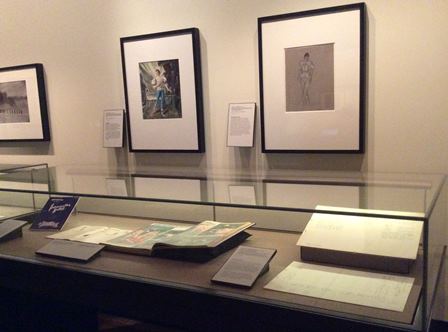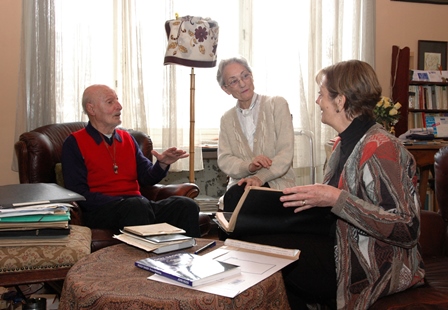In its Treasures Gallery, the National Library of Australia currently has one display case devoted to a production by the Borovanksy Ballet, Les Amants eternels (The Eternal Lovers). When I looked a few days ago the display contained the notated score (Laban) for the ballet, the work of Meg Abbie Denton; a Borovansky Ballet program giving details of performers and creative personnel; a double page spread from The Australian Women’s Weekly published in the issue of 12 March 1952; and on the wall above the display case a costume design by William Constable for the character of Romeo in the ballet, and a drawing in pastel and charcoal on velvet paper by Enid Dickson of Paul Grinwis as Romeo. The Constable design is to be removed shortly (for preservation reasons) and will be replaced by photographs. The rest of the material will remain for a few more months.

The Eternal Lovers was created by Grinwis, a dancer with the Borovansky Ballet in the 1950s. It received its world premiere in Melbourne in December 1951 and remained in the Borovansky Ballet repertoire until 1960. As Alan Brissenden has recorded in his and Keith Glennon’s Australia Dances:
Paul Grinwis conceived this ballet as a continuation of the story of two lovers, called for the sake of convenience Romeo and Juliet, when they awake in after-life. Its focal point is a struggle between the spirits of Love and Death, Love being finally victorious.*
At the premiere, Grinwis danced the role of Romeo, Kathleen Gorham that of Juliet, with Bruce Morrow taking the part of the Spirit of Death and Helene Ffrance the Spirit of Love. The ballet was danced to Tchaikovsky’s Romeo and Juliet Fantasy Overture.
Sadly, the National Library no longer has a dance curator. It has an extensive and wide-ranging dance collection, built up as a result, firstly, of the Esso Performing Arts and Oral History Archive Project (1988–1991); then Keep Dancing! a collaborative venture with the Australia Council, Ausdance and the National Film and Sound Archive (1997–2001); and between 2002 and early 2013 as a result of having an in-house dance curator. So it is good to see that at least a small gesture is being made to give a very tiny part of the material some visibility. The current display reveals, again in a very small way, the kinds of areas in which the dance material is held—art works, ephemera, notated scores, popular magazines are present, and photographic material is coming. The captions refer to interviews, although there is no sound capture from the interviews.
The dance collection at the National Library is incredibly rich, crosses eras and dance styles, and is supported by extensive material from other art forms and by organisational records, all held by the Library across its many formats. I can but hope that more material will be displayed, and even that eventually someone will take the trouble to add to out-dated records—at the very least a few dates of death need to be added to Trove records.
As an aside, in 2005 I had the pleasure of visiting Grinwis and his beauitful, ever-vibrant wife, Christiane Hubert, also a dancer with the Borovansky Ballet for a few years from 1954. I had hoped to record an oral history interview with Grinwis, but at the time he was not amenable to the idea. Another occasion never arose and Grinwis died about a year later in 2006. Hubert, I believe, moved back to Paris but I am not sure if she is still alive.

Michelle Potter, 10 January 2015
* Alan Brissenden and Keith Glennon, Australia Dances. Creating Australian Dance 1945–1965 (Adelaide: Wakefield Press, 2010), p. 20